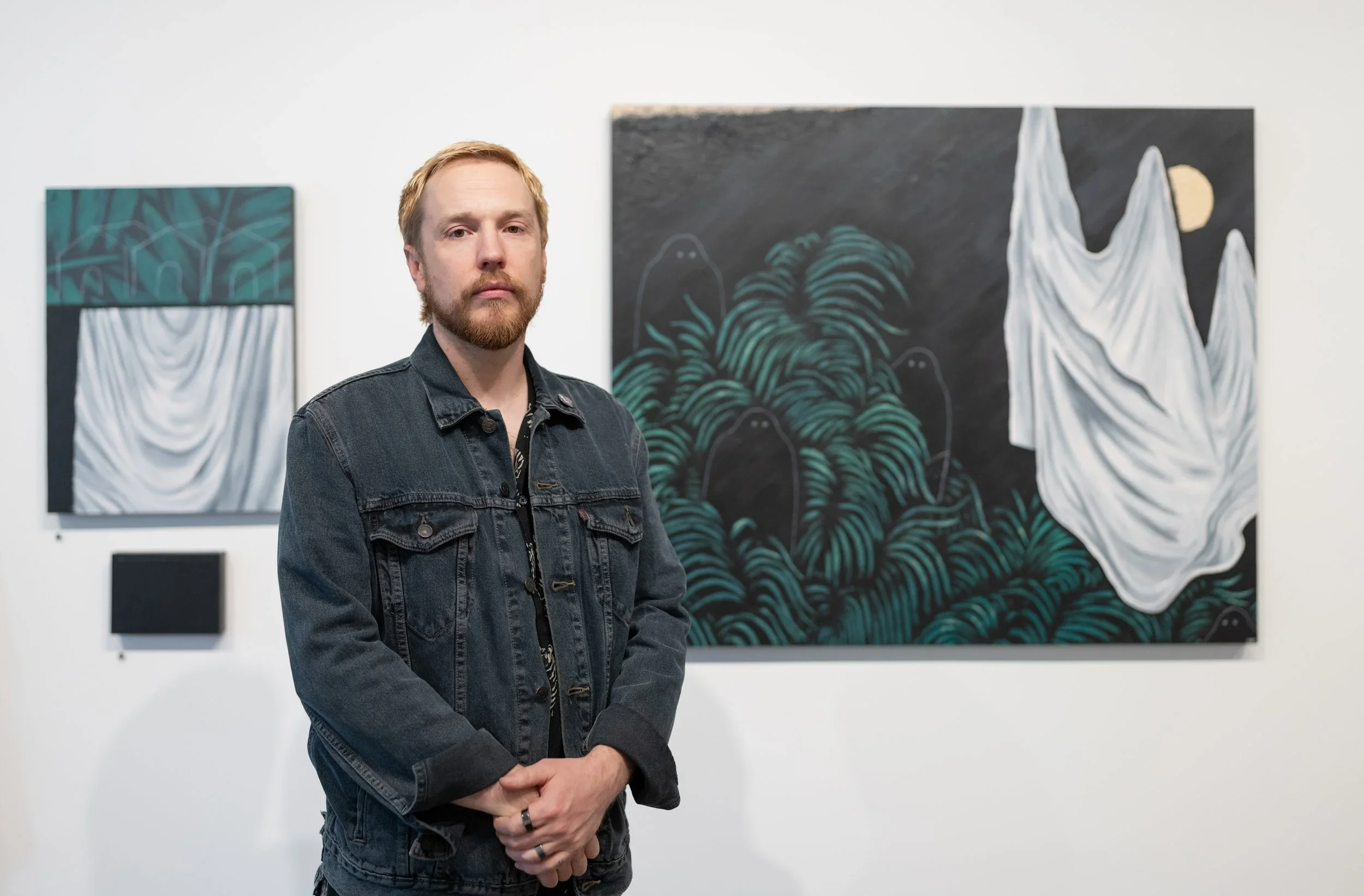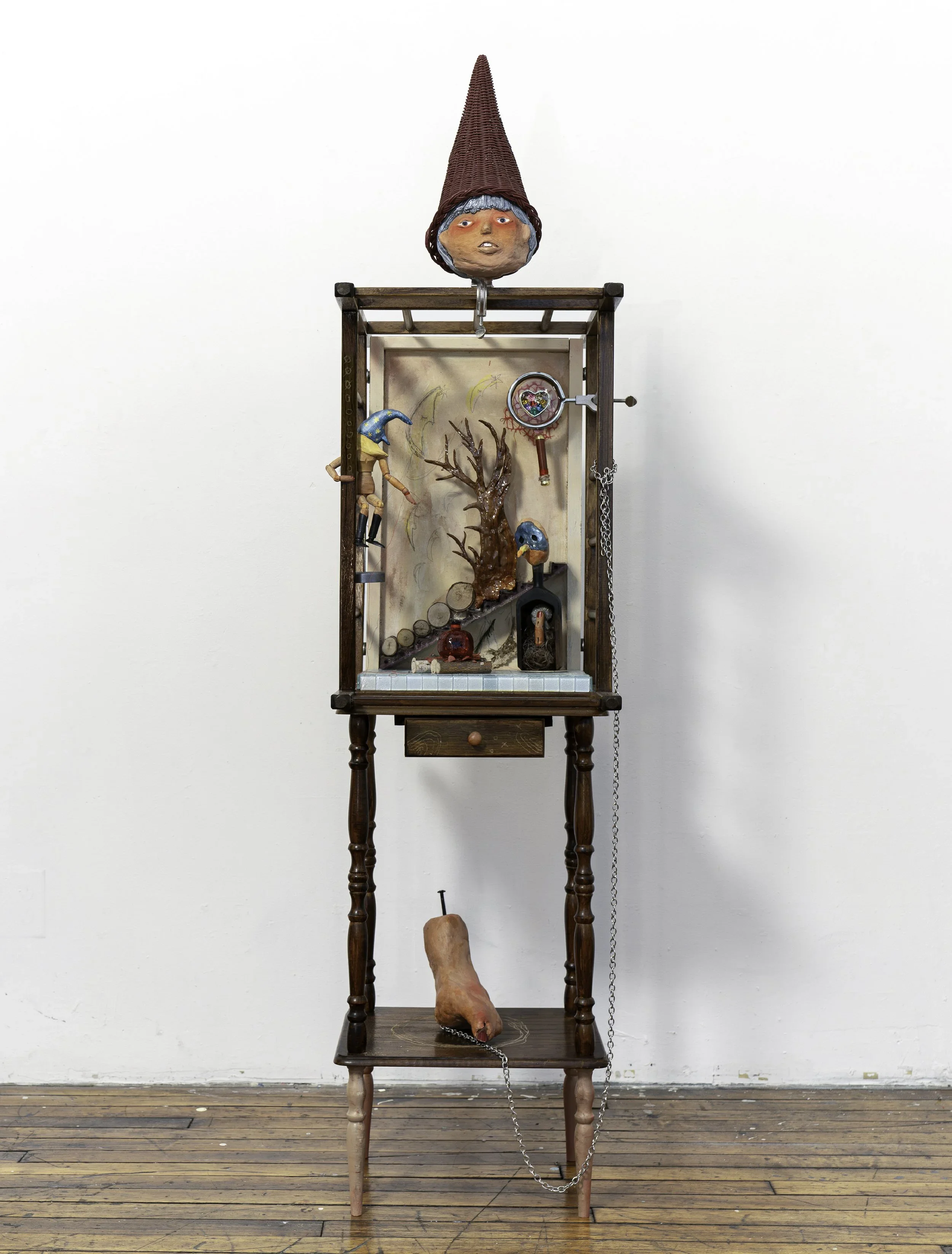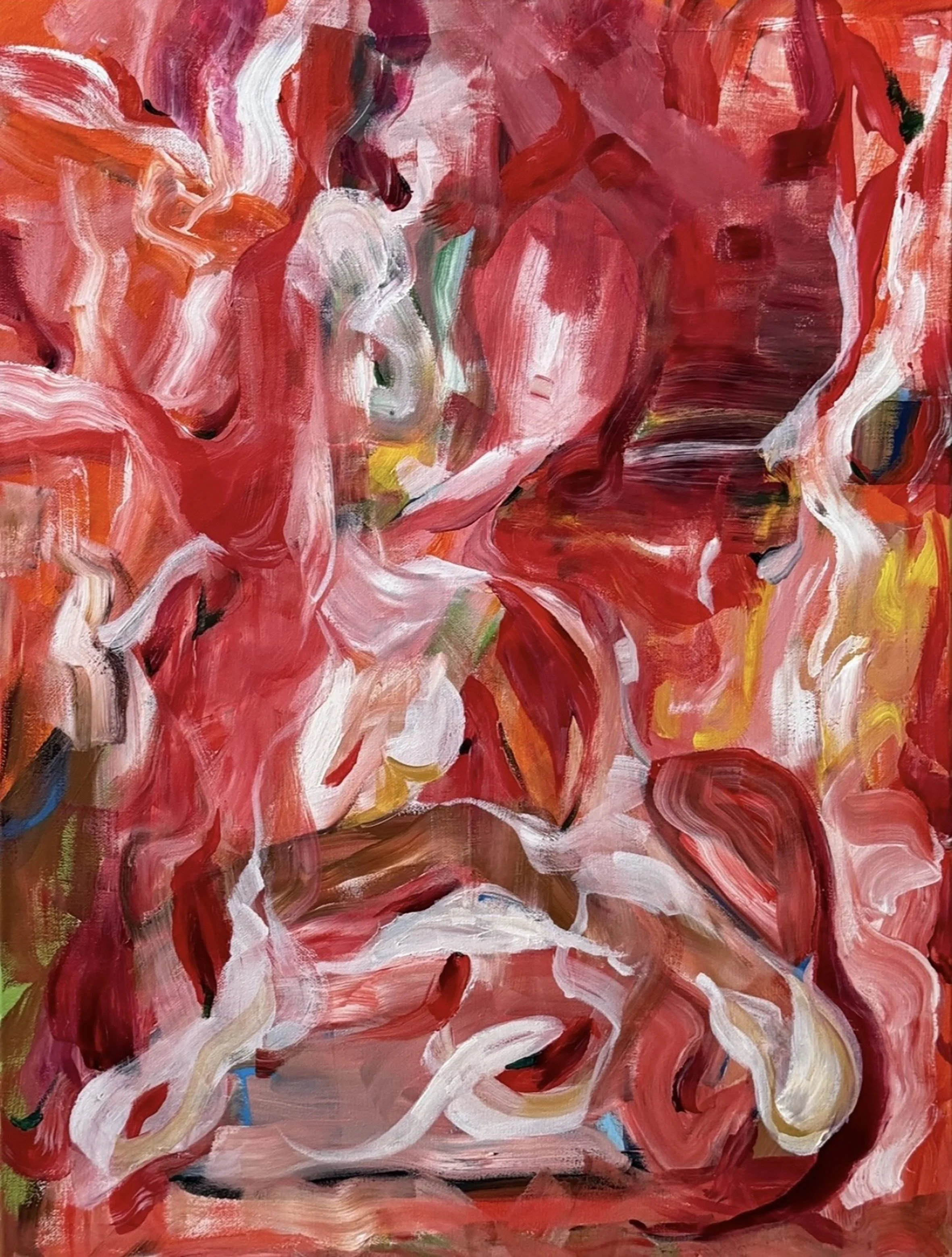10 Questions with Yuying Li
Al-Tiba9 Art Magazine ISSUE19 | Featured Artist
Based in London, Chinese artist Yuying Li translates ancient Eastern philosophies into contemporary visual narratives. With a Bachelor's in Chinese Painting from Zhejiang University and a master's in Print from the Royal College of Art, she bridges traditional ink techniques with modern media. Her work, which often features monoprint, ink wash, and mixed media, explores the "concretisation" of a spiritual home. She converges elements of the human body, nature, and deep space to blur the lines between them, echoing the Taoist ideal of "human and nature in one." Her introspective work has been recognised in a number of exhibitions across the UK and China. Recent highlights include "In Betweens" at London's Southwark Park Gallery and a series of shows in China, such as the "Nanling Biennale of Illustrations" and "Bronze Light" in 2024. These exhibitions highlight her ongoing exploration of humanity's intrinsic connection to nature and the quiet moments of tranquillity found within.
Yuying Li - Portrait
ARTIST STATEMENT
Yuying Li's art explores the concept of a "spiritual home", a peaceful, placeless sanctuary found in unexpected elements, from a withered tree to a speck of cosmic dust. Inspired by an ancient Chinese poem about the interplay of dreams and reality, she uses a dynamic balance of black and white to explore this theme. Her process involves allowing ink to flow freely, sometimes creating a faint blue underlayer with gesso, which she then adorns with watercolours, pastels, and pencils. She converges elements of the human body, nature, and deep space to blur the lines between them, echoing the Taoist ideal of "human and nature in one."
Yuying's work is also influenced by Marlene Dumas's art, appreciating the vibrant chaos beneath a calm surface. She strives to evoke this same feeling, a deep sense of life bursting forth from a tranquil exterior. Ultimately, her art portrays a timeless, tranquil embrace between humanity and nature.
舍得 (Come and go), Ink, watercolor, gesso, oil pastel, pencil, 30x30 cm, 2025 © Yuying Li
Drawn from the Chinese philosophy of "letting go to gain," the concept of 舍得 (Come and go) explores life as a continuous cycle of material exchange, a constant flow of gaining and losing. This dynamic process mirrors our journey from nature's embrace to our eventual return to it.
The central question is how to find a peaceful, "spiritual home" amid this flux. This sanctuary might be found in the most subtle details: the curve of an iris petal or the quiet awareness at your fingertips.
AL-TIBA9 ART MAGAZINE ISSUE19
Get your limited edition copy now
INTERVIEW
You have an interesting background, having studied both at Zhejiang University and the Royal College of Art. How have these two educational experiences shaped your current artistic language?
My time at Zhejiang University greatly influenced my artistic themes, particularly its holistic approach to education and strong emphasis on art history and theory. We weren't just taught traditional Chinese painting techniques; we also delved into fields like art archaeology, ancient Chinese Taoist art, and Tibetan Buddhist sculpture. During this period, I visited museums in cities like Nanjing, Shanghai, and Suzhou. I was especially drawn to some funerary objects from the Western Jin Dynasty (266-316 AD). These ceramic jars had beautiful, multi-layered pagodas on top, adorned with miniature figures, animals, and even mythical creatures. The jars had small openings, which people believed allowed the soul to be guided to immortality. This sparked my interest in the concept of achieving immortality, and my art archaeology courses later provided a deeper understanding of this topic. This led to the questions my current work explores: In an age where data serves as a spiritual vessel for humanity, can we find that ancient sense of "nature and human in one" (天人合一)? And in what form might it appear today?
The artistic form of my work evolved during my time at the Royal College of Art, thanks to its interdisciplinary environment. The print program, in particular, offered invaluable opportunities for external exhibitions and critique. Thisallowed me to hear perspectives from other professionals in the field. In February 2025, I exhibited a digital illustration based on the "Biographies of Immortals" (列仙传) at the Southwark Park Gallery. The feedback from other professionals and peers prompted me to rethink the suitability of using narrative illustration for the "nature and human in one" theme, as well as how the presentation of my work affects its visual impact. Later, on a spontaneous study trip to the Centre Pompidou with classmates, I became fascinated by the work of Jean Fautrier and Kurt Seligmann. Their work was a major influence, and it is what shaped the form you see in my current art today.
舍得 (Come and go), Ink, watercolor, gesso, oil pastel, pencil, 30x30 cm, 2025 © Yuying Li
During your training, you had the chance to approach traditional Chinese painting as well as contemporary printmaking. How did you come up with your style and practice? Where did you get inspiration from, and how did you merge such different approaches?
I would say my work isn't so much a fusion of traditional Chinese painting and contemporary printmaking, but rather a series of experiments with materials. Ink wash painting and printmaking are simply methods that I often use because oftheir inherent randomness.
Before I began studying Chinese painting, I primarily used pencils, acrylics, markers, and oil pastels. Unlike ink wash, these materials are precise and easy to control, which meant the final result was almost identical to the initial sketch. As my creative focus shifted, I began to incorporate a wider range of materials. It was during this process that I discovered some materials produced unpredictable, random effects over time. For example, oxidised iron powder creates irregular brown precipitates. These random changes didn't detract from the work; instead, they integrated seamlessly, which is when I first became interested in the randomness of materials.
On a visit to an art gallery, I noticed the print works of Dame Elizabeth Frink. These small-scale prints, primarily of animals and figures, had a strong sense of fluid texture in the main subject, which stood in stark contrast to the clearbackground. This vibrant texture reminded me of the "splashed-ink method" in Chinese painting, where ink is splashed directly onto Xuan paper, allowing it to spontaneously form unique shapes and marks. Both the ink play and the texture in Frink's prints had a strong sense of fluidity, and it sparked the idea of combining oil-based inks with water-based materials. After some experimentation and the introduction of other media like pencils and gesso, my current style was born.
Your technique involves a careful interplay between control and spontaneity, as you explain in your statement. Can you walk us through a typical creative process in your studio?
My creative process is a continuous dialogue between control and spontaneity, with the two constantly intertwining to shape the final artwork.
In the early and middle stages of a piece, my focus is on the raw instinct of the materials and my body. I see the random marks left by my tools as an extension of my own senses, and I hope viewers can feel the interaction between my movements and the canvas through these marks. I use a brush to drip and splash ink onto the surface, then randomly shake the canvas to let the ink spontaneously form various shapes. While the ink is still semi-dry, I randomly layer on deeper tones. Finally, I use materials like paper towels or plastic wrap to scrape at certain areas, giving the colours a richer sense of depth and layering.
After this initial phase, I borrow a step from traditional Chinese Gongbi painting: applying layers in small, repeated applications. Once the basic shapes are established, I build on them by adding materials like watercolours and Gelli Plate printing inks to create more specific, yet still random, forms. This isn't a fixed process and can be repeated dozens of times.
When the materials have taken on more concrete shapes, I return to a state of control. I deliberately use tools like pencils and brush pens to refine these shapes, making them resemble specific images. This process of gradually transforming intuition and chaos into an organic whole is part of my creative philosophy, a 'yin and yang' transformation. This dynamic balance between rigorous control and free expression is at the very heart of my work's unique vitality.
归一 (Reunion), Ink, watercolor, gesso, oil pastel, pencil, 30x30 cm, 2025 (2) © Yuying Li
归一 (Reunion), Ink, watercolor, gesso, oil pastel, pencil, 30x30 cm, 2025 © Yuying Li
The idea of a "spiritual home" is central to your practice. What does this concept mean to you personally, and how has it evolved in your work over time?
For me, the concept of a "spiritual home" is a core driving force behind my work. It's about achieving a state of continuous self-dialogue, tranquillity, and focus. In that sense, certain moments and spaces in my creative process are my personal spiritual homes. This feeling is like an inner sense of belonging and peace that goes far beyond any physical space. More broadly, my art and my creative process are an attempt to find a peaceful "home" for myself and for the viewer, a place to reconnect with our inner selves and with nature amidst our fast-paced, uncertain lives. This "home" could be a memory, a phrase, or a single action.
In my early work, the idea of a "spiritual home" was often very literal and hadn't yet formed a complete system. It appeared as specific scenes: mythical mountains from legends, a deep blue space with a single beam of light, or a surreal space with dew drops suspended in the air.
As I began to incorporate Taoist philosophy, my focus shifted from the external environment to the inner world and an abstract sense of nature. The work became less about visual scenes and more about an intuitive experience.
Now, my focus has evolved to explore a collective and shared memory. I'm trying to discover a space for spiritual dialogue that transcends cultural and geographical boundaries. This allows the "spiritual home" to become an open, co-created concept rather than a closed, personal fantasy.
You often merge elements of the human body, nature, and the cosmos. How do you decide which forms or symbols to use when working with such expansive, interconnected themes?
My work's elements come from historical Chinese iconography rooted in the "nature and human in one" (天人合一) cosmology, which I've then reshaped using my own vague memories of modern natural landscapes.
When I was researching historical images related to this theme, a series of Han Dynasty (25–220 AD) tomb bricks caught my attention. These bricks were used in burial chambers and often depicted people's imaginations of the afterlife and a second life. One particular set of patterns showed a tree with an extremely winding and twisted trunk. At the top of the tree often stood winged figures known as "yuren" (羽人), human-headed, bird-bodied beings, who were seen as emissaries guiding souls to the celestial realm. This tree, called "Fusang," was considered a sacred tree that connected the human, divine, and underworlds.
This image made me wonder: is this scene, as people's imagination of where the soul goes, the ultimate form of the unity between man and nature? Does it imply that, within the "nature and human in one" cosmology, the spiritual return is manifested as a combination of human body parts and specific natural elements?
Additionally, descriptions of immortals in texts like Zhuangzi's "Xiao Yao You" and the ancient classic Biographies of Immortals "Lie Xian Zhuan" often depict them as a visual manifestation of this unity, combining human body parts with natural elements like birds and snakes. This is why I choose to merge human anatomy with specific natural elements in my own work.
The more specific elements in my paintings, such as unidentified flowers, algae-like plants, and dry tree trunks, are mostlyderived from the random patterns created during my experimental process. I shape these patterns based on my vague, early memories of the organisational structures of certain animals and plants. They become a blended, familiar, and universally symbolic representation of nature, designed to evoke associations in the viewer. This association might be a tree they planted as a child, or perhaps an extinct deep-sea algae from a science magazine they once read. For each person, the imagery of nature is entirely unique.
归一 (Reunion), Ink, watercolor, gesso, oil pastel, pencil, 100x100 cm, 2025 © Yuying Li
Your work often embraces a restrained palette, primarily black and white, occasionally softened with shades of blue, yet it conveys deep emotional resonance. How does colour, or the deliberate absence of it, shape the meaning and impact of your work?
In my work, black and white represent a dynamic balance formed during the mutual transformation of matter. In my piece, "Come and Go", this balance is about loss and gain, reflecting the philosophical idea that you must sacrifice something to gain something else. In "Reunion", it's about the connection between the body and nature, birth and return, the idea that we are born from natural elements and ultimately return to them.
I draw inspiration from the concept of black and white interaction in the ancient "Taiji Diagram." Black and white represent the two Qi, yin and yang, from the Taoist worldview. They are in a constant state of mutual transformation and complementation, which together form the entire world. In my creative process, black ink flows freely in water, and the white paper interweaves with the black. This sometimes creates faint traces of blue, which goes beyond the black and white themselves. This serendipitous effect aligns perfectly with the Taoist philosophy of "one produces two, two produces three, and three produces all things."
I mentioned earlier that my exploration of the historical iconography of "nature and human in one" is centred on stone carvings from the Han Dynasty (206 BC–220 AD). These carvings were originally an integral part of tombs, and the scenes, from everyday life to mythical legends, combined with the three-dimensional structure of the tomb itself, presented a complete and massive worldview of life's transformation under the influence of this philosophy.
However, as an audience, we often encounter these carvings in black and white and in fragmented forms. They are typically preserved as black-and-white rubbings, brick by brick, in museum archives. The contrast between this fragmented, monochromatic presentation and the original, grand, and three-dimensional content is striking. It gave me the feeling of slowly uncovering just a small corner of an immersive world. From the scenes of "Yuren" and the "Fusang tree"to depictions of sacrifices, hunts, and even hell and paradise, this experience inspired me to present my own work in a fragmented, black-and-white format, attempting to distil these grand Taoist philosophical concepts into small, focused imageries.
The ancient Chinese philosophy of 舍得, or "letting go to gain," appears as a conceptual thread in your recent work. How do you approach translating this intangible idea into visual form?
This was actually the most critical question for me in the early stages of my work. I interpret it mainly through two approaches.
The most direct way is through negative space, or a background that is so clean it's almost absent. This emptiness isn't a void; it's a space for contemplation. This technique is very common in Song Dynasty (960-1279) landscape paintings. This process of "letting go" of the background is done in order to "gain" a more focused and powerful visual centre.
The other approach is to express it directly through the elements in the painting. The inspiration comes from some phrases I heard as a child, though I can't recall the exact source. People often use "sand in the hand" to describe things that we try to "grasp" but lose more easily the "tighter" we hold on. Just like trying to tightly hold sand in your palm only makes it slip through your fingers faster. This inspired me to use the contrast between an open and a clenched hand to express this theme.
一 (One), Ink, watercolor, gesso, oil pastel, pencil, 60x40 cm, 2025 © Yuying Li
舍得 (Come and go), Ink, watercolor, gesso, oil pastel, pencil, 65x65 cm, 2025 © Yuying Li
From London to China, your exhibitions reflect a growing international recognition. How do audiences in different cultural contexts respond to your work? Do you notice different readings or emotional reactions?
I have indeed observed some subtle differences in how audiences from different cultural backgrounds respond to my work.
In cities like Hangzhou and Beijing, where there's a strong foundation of Taoist culture, audiences often begin by looking at a work's title and then use that as an entry point to interpret its overall abstract meaning. Interestingly, when I've deliberately mixed up all the artwork titles and placed them together, most of these audiences could quickly and accurately match each title to its corresponding piece.
During my exhibitions in London, audiences tend to be more focused on specific visual elements, what's happening within the frame, and their own position relative to the work. The titles are rarely mentioned. The first impressions from London audiences often involve terms like "plant life," "deep time," "another life form exploding," and "inner world or other places." They frequently engage in discussions to identify specific elements, such as whether a form in my work "One" is an eye or a galaxy, or if a scene in "Reunion" is set in the ocean or on the surface of the moon.
Regardless of cultural background, the overall consensus is that most viewers feel a sense of neutrality, tranquillity, or even a removal of emotion from my work, which I consider a successful outcome. The diversity of audience responses has also led me to unexpected evaluations, such as the use of words like "ambiguity" and "unknown." These kinds of comments offer me, as the artist, new perspectives and inspiration.
Taoist ideas, such as the unity of humans and nature, run through your visual narratives. How do you see your practice contributing to today's conversations about ecology, spirituality, and cultural continuity?
My work is indeed rooted in Taoist philosophical concepts and is often named after them. I see my practice as a way to reinterpret the significance of these ancient aesthetics and wisdom in a modern context.
My work introduces a blend of ancient ideas with my own vague, universal memories of nature, rooted in the philosophy of "the unity of human and nature" (天人合一). I hope to evoke viewers' own memories of nature within their personal environment and encourage them to use my visual language to contemplate how these natural elements interact with them. This encourages people to mindfully perceive their own ecosystem, even in small details like a petal or the texture of a small piece of tree bark. By doing so, they can re-examine their relationship with the Earth's ecosystem and be inspired to take sustainable action.
As my ongoing theme, "Spiritual Home," suggests, Taoist concepts like "following the Dao" and "Wu Wei" are not about passive withdrawal, but about a spiritual state of aligning with the natural cycle of all things and seeking inner harmony. In a sense, I hope my art can help people find, or even become, their own "Spiritual Home." My work provides a brief moment of detachment and tranquillity, offering a quiet and neutral space. Especially in our fast-paced, fragmented modern lives, I invite viewers to slow down, look inward, and reconnect with their own bodies, their inner world, and their environment to find a deeper sense of presence and harmony.
Finally, my work is also a contemporary response to traditional Chinese culture. It may have started with tomb imagery and philosophical theories from over 2,000 years ago, but it can still be reinterpreted and understood today through modern visual language and media, and in a way that is broadly cross-cultural. When this wisdom is presented to the audience through a small-scale lens, it reminds me of those tomb carvings with their grand cosmic views. After thousands of years, we encounter them as fragmented, brick-sized black-and-white rubbings, and reading them feels like turning a corner of history.
False gods, Wire, wood, paper pulp, aluminum foil, 40x50x40 cm, 2024 © Yuying Li
Lastly, looking ahead, are there new themes, materials, or formats you're hoping to explore? How do you envision your work evolving in the coming years?
I'm always thinking about what's next and find it exciting to explore new materials. My creative journey is very muchabout staying open to new ideas and processes.
My next project will delve deeper into a new theme: the relationship between the ocean, the human body, and our earliest collective memories. This is a natural progression and deepening of the "unity of nature and human" cosmology I've been exploring. The project will continue a series I started a few years ago, inspired by the ancient Tang Dynasty poem, "Jiao Ren Ge." This beautiful and mysterious poem describes a deep-sea world where "Jiao Ren" live among fish and weep pearls as a sign of gratitude. This isn't just a distant myth, but a romantic reflection of the "unity of nature and human."The harmonious coexistence of "Jiao Ren" with sea creatures and the fusion of human and fish forms within the "Jiao Ren" themselves can be seen as an ideal paradigm of "the unity of nature and human" within a marine ecosystem.
My previous works often used a structured, square arrangement to echo the philosophical meaning of "Jiu Jiu Gui Yi," or the return of all things to a unified whole. In this new project, I plan to adopt a more irregular and free-flowing arrangement. I'm also considering integrating new materials like transparent resin, fine sand, and quartz into my work to further explore these themes.
Artist’s Talk
Al-Tiba9 Interviews is a curated promotional platform that offers artists the opportunity to articulate their vision and engage with our diverse international readership through insightful, published dialogues. Conducted by Mohamed Benhadj, founder and curator of Al-Tiba9, these interviews spotlight the artists’ creative journeys and introduce their work to the global contemporary art scene.
Through our extensive network of museums, galleries, art professionals, collectors, and art enthusiasts worldwide, Al-Tiba9 Interviews provides a meaningful stage for artists to expand their reach and strengthen their presence in the international art discourse.


























